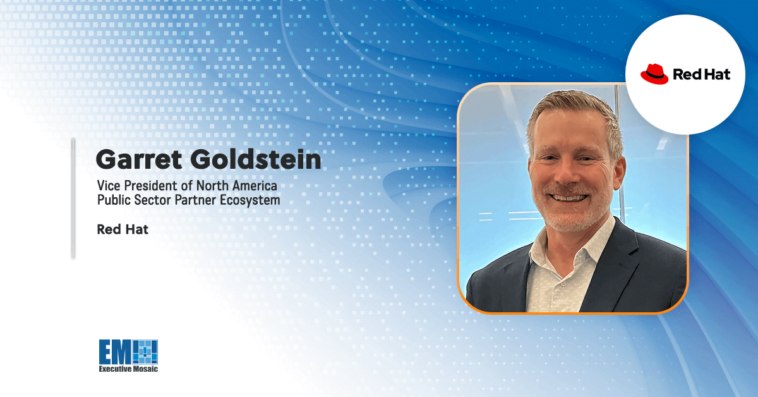Garret Goldstein has an extensive background in the information technology market, having spent over three decades in a wide range of roles delivering and selling IT solutions. He is a strong advocate for partnerships between companies with shared goals, something he views as highly beneficial for serving public sector clients.
In his current role as vice president of North America Public Sector Partner Ecosystem at Red Hat, Goldstein leverages his wealth of experience in partner relations to empower joint efforts between his organization and key collaborators. What has kept him in this space is that he has “really enjoyed the notion of finding areas where two or more companies bring something unique to the table.”
Goldstein recently sat down with ExecutiveBiz for an Executive Spotlight interview, in which he detailed Red Hat’s approach to partnerships and highlighted the ways the company is changing how it engages with the ecosystem.
Tell me about Red Hat’s Public Sector Partner Ecosystem. Why is it so important to Red Hat and what is changing?
We are really transforming how we go to market with our partners. This includes the ways we think about individual partnerships as well as the overall ecosystem and how we organize ourselves internally around the ecosystem. With changing dynamics in how Red Hat sells its software, the overall market and our broader ability to positively impact the mission of our government customers, we need our partnerships more than ever – we cannot do it alone.
At Red Hat, we have been making investments into key partnerships through which we’ve built out the capability to deliver a comprehensive solution that targets a particular business or mission problem that our government customers are having. In these cases, we’ve made a commitment and investment in the partnership with a goal of solving specific problems or sets of problems. This is also what differentiates partnerships, where together you bring something unique to customers.
We’re making changes so that we are placing bets with a focus set of partnerships, investing and providing incentives to go out there and find ways in which we can further help our government customers.
We are also taking a full ecosystem approach, so while we make investments in individual partnerships, we also want to make sure that we’re building partnerships across the ecosystem and not just with one type of partner. We’re building partnerships with large SIs, with regional SIs and organizations in key state capitals. We understand that we have to invest and build partnerships all across the country and with organizations that have specific focus areas, whether it’s the Intelligence Community, federal health agencies or anything else. We’re also working with traditional value-added resellers, cloud providers and independent software companies or hardware providers as well as advisory firms.
What is really interesting is that we can begin to take multi-partner approaches where we look at ways a solution provider can take the best of what Red Hat does as well as the best of what other software companies do and orchestrate across that entire partner ecosystem at multiple levels. We can look at a government agency and know who the players are, what’s important, what’s top of mind for those particular customers, what those partners are interested in and how we can work together to help solve these issues.
Where are you seeing Red Hat’s biggest ability to positively impact mission and how are partners involved?
Right now at Red Hat, we’re seeing three exciting areas among many. The first is what we call virtualization modernization. Over the past year, there have been shifts in the virtualization landscape. These shifts have the potential to impact infrastructure cost for running virtualized workloads, but as well provide organizations the opportunity to modernize their approach. It becomes a conversation about moving from approaches, architectures and technologies that have been around for over 20 years to modern, cloud native architectures.
We are finding that organizations that modernize toward running VMs and containers on a single platform reduce complexity because they are standardized, minimizing risk and gaining operational efficiencies. A unified IT platform also enables consistent security policies and controls. Finally, by migrating disparate VMs, our customers get the most from their existing virtualization investments, while taking advantage of cloud-native architectures, streamlined operations and management and new development approaches. As this is a discussion with customers about modernization, it is an ideal conversation for our partner ecosystem to lead.
The second area with lots of buzz is artificial intelligence. There are so many incredible companies doing incredible things around large language models – just the general algorithms that are being developed today – and, of course, the chip manufacturers that enable compute power. We are approaching this at a different angle.
There are some incredible needs that our government customers have as it relates to AI, but how do you operationalize that? How do you industrialize that, whether it be AI at the edge, for individuals in our armed forces or others that need decision making when they are out in the field – or even in general? How do you bring the same ideas of SecDevOps notion, infusing security, release trains, automation, etc., to AI?
How do you ensure that you’ve got a common operating platform, whether that AI lives in the cloud, on premise, at the edge or a ruggedized compute type of hardware platform in a tank or on a plane? How can you ensure that you can efficiently and effectively apply those same kinds of standard SecDevOps principles for AI as well, the different considerations we have and the things you need to do to train and refresh models? And how do you apply that uniformly no matter where? This is an incredible opportunity for our partner ecosystem.
The last piece, though not as exciting as the first two, is critically important for our government customers, and that’s around enterprise and what we call ‘event-driven’ IT automation.’
The notion of automation has been around a long time. In fact, most government customers are familiar with it from a business process perspective using RPA type of technologies. But from our perspective, it’s taking that same thought process and applying it to IT automation.
We all know how incredibly tight the technical workforce is, so it’s hard to find lots of technical folks. When we can infuse automation across their enterprise, it allows them to focus their hiring and their needs of technical resources on the modernization projects to further the mission. This makes enterprise automation and event-driven IT big opportunities, both for the government and Red Hat’s partner ecosystem. Our goal is to positively impact the mission of our government customers, and we can’t do that without partners, whether we are talking about virtualization modernization or helping our government customers plot an AI future or automate.
These topics are always viewed within the context of a broader modernization effort. More than likely, it’s probably a combination of our partner ecosystem. For example, it might be a multi-cloud scenario that includes a cloud service provider and an SI who’s helping a customer take that journey. That’s a partner ecosystem play. Similarly, it’s automating events they get from their monitoring tools and connecting those with their service management tools – all work that needs to be done – and it’s a journey, something that our partner ecosystem is extremely skilled at helping with.
What are some examples you are seeing across the ecosystem of positive mission impact?
We’re never exactly where we want to be – we’re always striving for even better stories and more impact. We still see daily examples, some big, some small, some from new partners, some from partners that have been in our ecosystem for some time, making a positive impact on government missions while at the same time mutually growing our business together.
An example is a large state health exchange that one of our key and critical partners is implementing. It’s a multi-year modernization effort, and we are a major part of that, providing a common operating platform from which they can modernize. It has a cloud component as well as an automation element, and we know for sure that we are saving that government entity money. We are also helping them provide a better service, which has already had a positive impact on the constituents.
Red Hat is sponsoring the Potomac Officers Club’s 2024 Cyber Summit on June 6, which will feature a wide range of cyber experts from both government and industry in various keynote speeches and panel discussions. To learn more and register to attend the event, click here.






